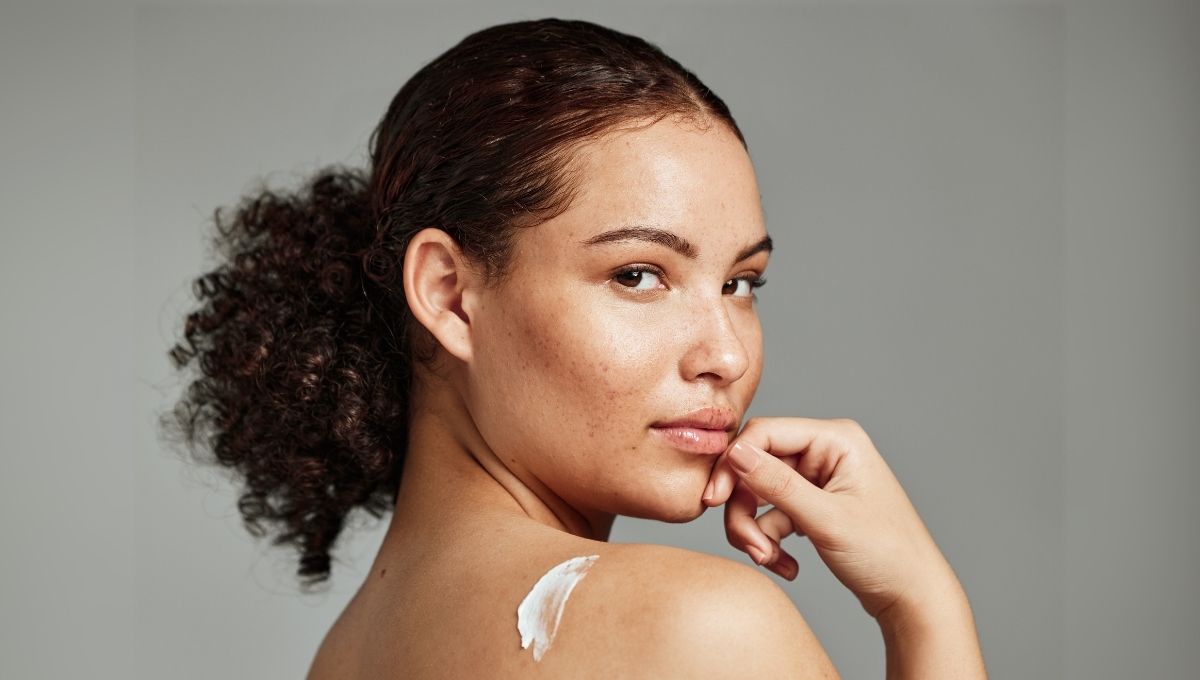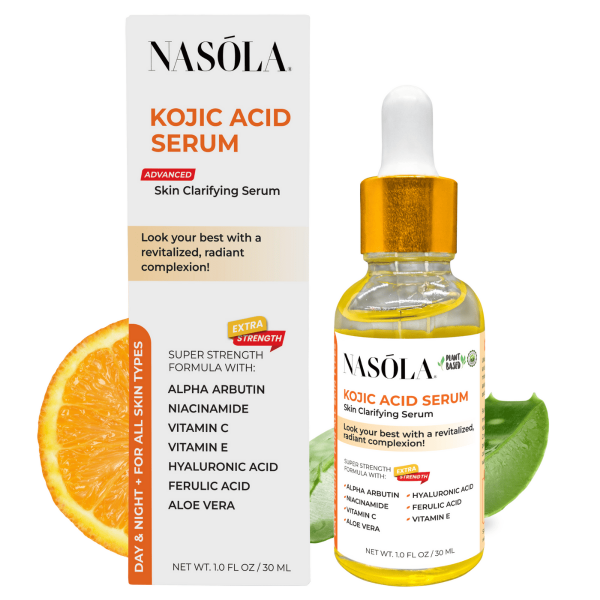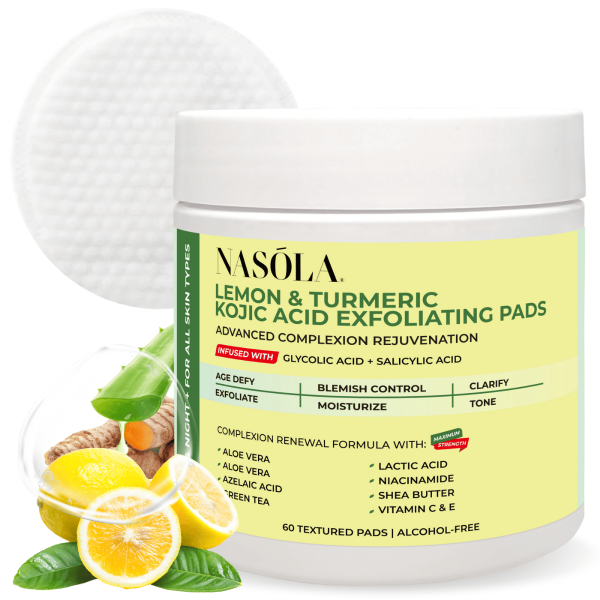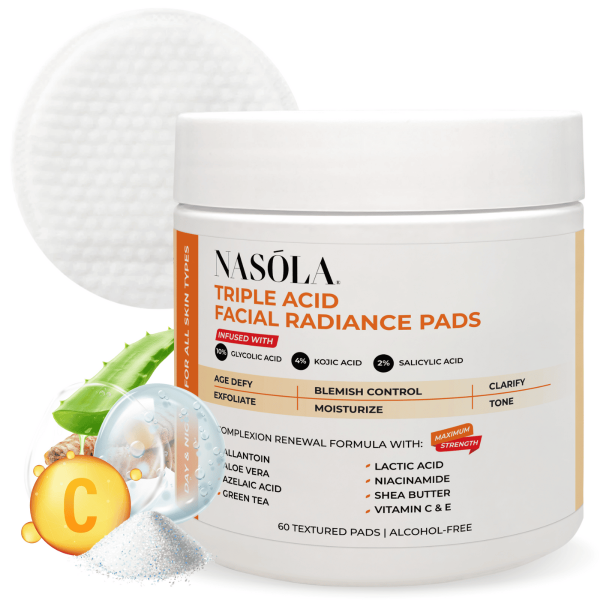Imagine standing in front of your mirror, gently tugging at a stubborn dark spot that’s outstayed its welcome. You’ve tried everything—peels, serums, “miracle” creams—but somehow, those patches say: not today.
Here’s where the best kojic acid cream for skin whitening comes in—and yes, it matters WHICH kojic acid cream you choose.
Kojic acid has carved out a space in the world of skincare queens (and kings!) looking for real results—especially those battling pigmentation, melasma, or dullness with no end in sight.
In this guide, we’re diving deep. You’ll learn what kojic acid actually does (like, seriously), how to choose the best formula based on your skin type, and why the right supporting ingredients change EVERYTHING.
And if you’re curious about top-tier picks? Trust me, we’ll talk Nasola… a lot. 😉
- What is Kojic Acid and How Does it Help with Skin Whitening?
- Popular Skincare Ingredients that Complement Kojic Acid
- The Best Kojic Acid Cream for Skin Whitening: How to Choose
- How to Enhance Kojic Acid Results with Exfoliation
- Advanced Treatments: Triple Acid Formulas for Brightening
- How to Use Kojic Acid Creams Safely and Effectively
- Identifying Your Skin Type Before Choosing the Best Kojic Acid Cream for Skin Whitening
- Common Mistakes to Avoid When Using Kojic Acid Products
- FAQs
What is Kojic Acid and How Does it Help with Skin Whitening?
So, let’s start with the obvious question—what even IS kojic acid? And what makes it magical for brightening up uneven skin tones? Simply put, kojic acid is a naturally derived compound, typically from mushrooms or fermented rice.
But don’t let its humble roots fool you. This ingredient is a powerhouse at tackling melanin overproduction.
When your skin has too much melanin concentrated in one area… hello, dark spots. Kojic acid steps in by blocking tyrosinase—an enzyme your body uses to produce melanin. Less tyrosinase? Less pigment. Simple, science-backed, and stunning results.
Perfect for:
- Melasma across cheeks or forehead
- Sunspots and liver spots
- Post-acne marks and blemishes
- Dull, lifeless skin that craves a glow
And if you need a place to start, the Nasola Kojic Acid Cream is a go-to choice. It targets stubborn pigmentation, gently exfoliates, and smooths texture—all without drying your skin out like harsh bleaches or hydroquinone creams.
Let’s just say… your hyperpigmentation may finally have met its match.
How Kojic Acid Works on Melanin Production
Kojic acid isn’t just trend-hyped. It works. More importantly, it works on a cellular level. The moment you apply a cream like Nasola Kojic Acid Cream, it starts interfering with melanin production in those darker patches via inhibiting tyrosinase.
This means:
- Your current spots begin to fade.
- New dark spots are less likely to form.
- Overall skin tone becomes brighter, smoother, and more even.
- It helps prevent pigment relapse from sun exposure—assuming you also wear SPF, of course!
Consistency is key. Most people begin seeing results between weeks 2 to 4, with continued results over time. And unlike chemical bleaches, kojic acid aligns beautifully with sensitive skin—when used correctly.
Common Uses and Skin Conditions Treated
People often think kojic acid is only for skin lightening. But it’s so much more than that. The benefits stretch across multiple skin types and concerns:
- Fades melasma from hormonal changes or sun exposure.
- Gently softens acne scars and post-inflammatory pigmentation.
- Evens out patchy complexions for a luminous finish.
- Restores a youthful glow, especially when paired with hydrating agents like aloe vera or hyaluronic acid.
That’s why the Nasola Kojic Acid Cream has become a go-to favorite—it’s not just about whitening. It’s about brightening intelligently and safely.
Popular Skincare Ingredients that Complement Kojic Acid
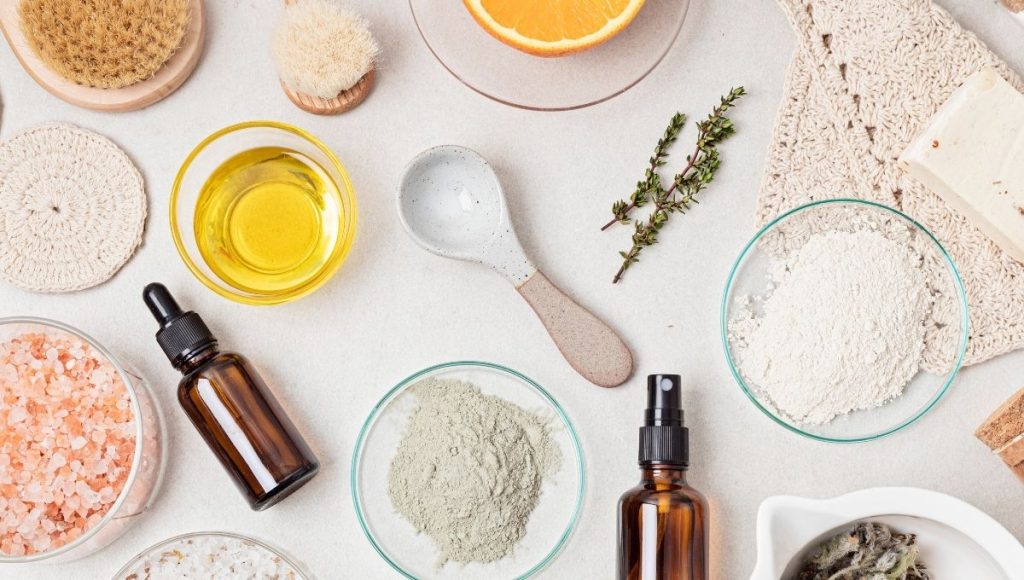
Look, no skincare superstar works best solo. Kojic acid shines, but its output sparkles brighter when paired with effective complements—LIKE niacinamide. Why? Because ingredient synergy multiplies skin benefits while reducing risk of irritation or dryness.
This section is your matchmaker moment… where kojic acid meets its bestie.
Ingredient Synergy: How Niacinamide and Kojic Acid Work Together
Niacinamide + kojic acid = the ultimate skin-brightening tag team. While kojic acid blocks melanin production, niacinamide strengthens your skin’s barrier, boosts hydration, and evens tone even further.
Benefits of combining these two?
- Boosted efficacy in fading hyperpigmentation
- Less risk of redness or irritation
- Improves elasticity and texture simultaneously
- Reinforces skin’s resilience against free radicals
This makes the Nasola Kojic Acid Serum a dream combo. It’s feather-light, absorbs quickly, and layers flawlessly under makeup or SPF.
Night serum? Day serum? Both. 🧴✨
Finding Products with Niacinamide + Kojic Acid
Here’s the catch—not every product labeled “kojic acid” includes niacinamide. So what do you do? You trust products that put thoughtful formulation first.
Nasola Kojic Acid Serum delivers that promise. It’s designed for:
- Beginners just getting into skin brightening
- Oily or combo skin types looking for a lightweight, non-greasy feel
- Sensitive skin needing non-aggressive actives
- People who want results without heavy layering
Bonus: It plays wonderfully with moisturizers, sunscreens, and other exfoliating treatments.
The Best Kojic Acid Cream for Skin Whitening: How to Choose
When deciding on the best kojic acid cream for skin whitening, don’t just grab the first tub you see on your explore page. There’s a method, my friend, and you’re about to master it.
Choosing the right kojic acid cream is all about concentration, calming additives, and reviewing how YOUR skin type reacts. So let’s end the guesswork once and for all.
Look for Safe Concentrations
More isn’t always better… in fact, with kojic acid, going too high increases risk of sensitivity and redness—especially if your skin is already inflamed.
The sweet spot? 1% to 2%.
Why that range?
- It’s strong enough to gradually fade melanin spots.
- Reduces risk of over-lightening or irritation.
- Safe for prolonged daily use with proper SPF.
- Dermatologist-approved across skin tones.
You guessed it—Nasola Kojic Acid Cream lands perfectly in that range, delivering optimal brightening while soothing deeply using natural extracts.
Opt for Formulas with Soothing Botanicals or Vitamins
A good kojic acid cream is layered with more than just the “whitening” agent.
Botanicals like aloe vera, vitamin C, and green tea extract all play a supporting role in:
- Calming down redness or inflammation.
- Strengthening your skin barrier against environmental stressors.
- Promoting regeneration for brighter, plumper skin.
- Adding hydration so you’re not just bright—but GLOWY.
That’s the real power combo living inside Nasola Kojic Acid Cream. Carefully curated plant-based ingredients work overtime to support both balance and brightness.
How to Enhance Kojic Acid Results with Exfoliation
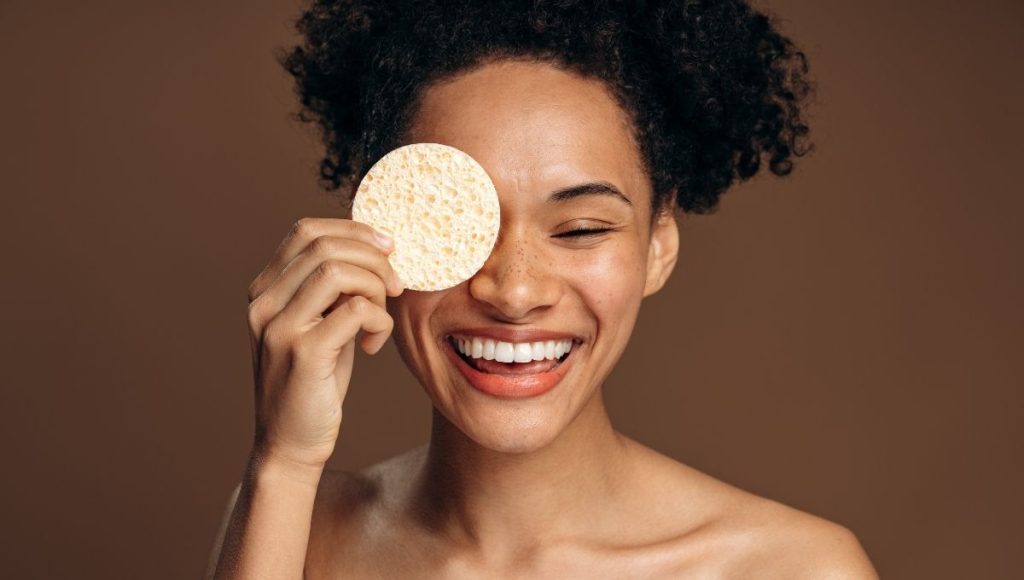
Here’s an underrated fact: even the best kojic acid cream for skin whitening won’t reach its full glory… without EXFOLIATION. Dead skin cells act like little blockers, preventing your actives from reaching the spots that need love the most.
Let’s break it down, beautifully and simply.
Why Exfoliation is Critical in Skin Brightening Routines
Your skin renews about every 28 days. But if you’re over 30 (hello 👋), that process slows down. Dead skin cells pile up, leaving you looking tired, patchy, and uneven.
By gently removing those cells, exfoliation:
- Unclogs pores and helps prevent breakouts
- Clears the way for kojic acid to penetrate deeper
- Reveals fresher, more even-toned skin underneath
- Improves absorption and efficacy of other skincare steps
Just don’t overdo it. 2–3 times a week is plenty, unless you’re using daily gentle pads.
Best Kojic Acid Exfoliating Pads to Try
My absolute favorite? Nasola Lemon Turmeric Kojic Acid Exfoliating Pads. These dual-action pads are:
- Loaded with lemon extract: a natural brightener
- Enriched with turmeric to reduce inflammation and blotchiness
- Infused with AHA/BHA for deep pore purification
- Balanced with kojic acid to break up melanin clusters
Minimal effort, maximum glow. Easy to swipe, impossible to forget.
Advanced Treatments: Triple Acid Formulas for Brightening
What if you want faster results? Or your pigmentation seems extra stubborn and deep-set? This is where triple acid formulas swoop in—fancy, effective, and still surprisingly gentle when done right.
What Are Triple Acid Formulas and Who Are They For?
Triple acid treatments mix multiple chemical exfoliants—usually glycolic, lactic, and kojic acid. Why? Each acid works a little differently:
- Glycolic acid removes surface cells
- Lactic acid hydrates while exfoliating
- Kojic acid reduces melanin production from below
- Together, they amplify one another without stripping your skin
Ideal for:
- Thick or congested skin types
- Darker, long-standing pigmentation
- Weekly “reset” treatments
- People who’ve used actives before and want more
When to Consider Nasola’s Triple Action Pads
Bold enough to tackle deep pigmentation but gentle enough for consistent use… that’s Nasola Triple Acid Facial Radiance Pads.
Why they work:
- A blend of glycolic, lactic, and kojic acid (hi, triple threat ✅)
- Resurfaces skin and accelerates renewal
- Minimizes acne scars, sun damage, and dull patches
- Gives visible brightness in just weeks
Pop one out, swipe, glow. Rinse the compliments later.
How to Use Kojic Acid Creams Safely and Effectively

Even the best kojic acid cream for skin whitening won’t work if you misuse it! No rushing, no 3x daily hoping for overnight miracles.
It’s about rhythm + patience = results.
Preparation: Pre-Cleansing and Toners
Before anything touches your precious face, cleanliness is key.
Steps to prep skin:
- Use a gentle cleanser with no stripping sulfates.
- Follow with a calming toner—rose water, witch hazel, or chamomile.
- Let skin dry completely to ensure max absorption.
- THEN apply your kojic acid product.
Think of this as prepping the “canvas” for a masterpiece.
Recommended Usage Routine
Here’s how to keep irritation away and progress steady:
- Start with every other night application. Build to nightly.
- Always moisturize after applying kojic acid cream or serum.
- NEVER skip sunscreen—kojic acid makes skin more sun-sensitive.
- Avoid layering with harsh acids unless using a balanced formula like Nasola’s pads.
Try beginning with Nasola Kojic Acid Serum before evolving into the Nasola Kojic Acid Cream for maximum glow-up safe and sound.
Identifying Your Skin Type Before Choosing the Best Kojic Acid Cream for Skin Whitening
One cream does NOT fit all. Your skin type heavily influences how products behave—what works on dry skin may clog oily pores, and sensitive skin needs extra TLC.
Knowing your type makes the journey toward clearer, brighter skin… so much smoother.
Determining if Your Skin is Sensitive, Dry, Oily, or Combination
A quick skin-type self-check:
- Oily: Shiny, visible pores, frequent breakouts
- Dry: Flaky, tight, rough patches
- Sensitive: Red, stingy, reactive to products
- Combo: Oily T-zone, dry cheeks
How to test?
- Cleanse face, wait an hour. No products.
- If you’re shiny = oily. Tight = dry. Red = sensitive. Patchy = combo.
Now you’re ready to choose your kojic acid product like a pro.
Product Recommendations by Skin Type
- Sensitive: Nasola Kojic Acid Serum offers controlled delivery with hydration and minimal irritation.
- Oily: Nasola Lemon Turmeric Kojic Acid Exfoliating Pads gently remove oil buildup while promoting clarity.
- Dry: Nasola Kojic Acid Cream deeply moisturizes while fading discoloration.
Avoid shortcuts. Make your skin’s needs the top priority.
Common Mistakes to Avoid When Using Kojic Acid Products
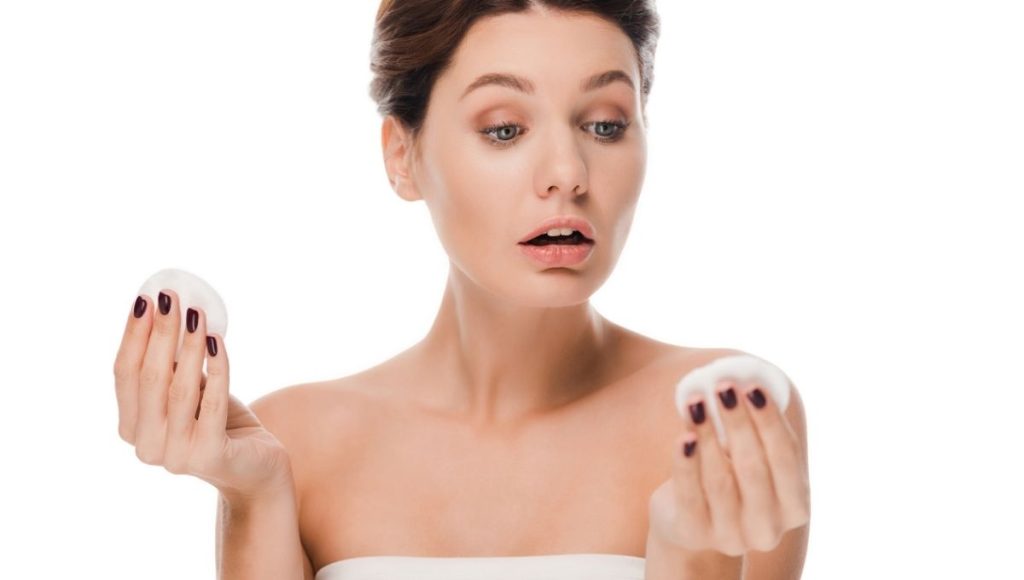
Listen—mistakes don’t mean you’re failing at skincare. It just means no one taught you better. But that ends today. Let’s correct those common missteps that could sabotage your glow goals.
Overuse Leading to Irritation
Your skin is NOT in a race. No matter how badly you want those spots to vanish overnight, kojic acid needs time—not pressure.
Avoid:
- Applying kojic acid too frequently without breaks
- Mixing with other harsh actives like benzoyl peroxide or retinoids
- Not hydrating or moisturizing afterward
- Treating irritation with more product
Less is more. Always.
Skipping Sunscreen
This is the big one—non-negotiable.
Why?
- Kojic acid makes your skin more vulnerable to UV damage.
- Sun exposure triggers more melanin (aka fights your product’s goal).
- Sunscreen helps lock in brightness and protect results.
- No SPF? Say goodbye to progress.
Add it to your cart. Add it to your calendar. Never skip again 🧴☀️
FAQs
The Nasola Kojic Acid Cream stands out due to its effective formulation of kojic acid and healing botanicals. It gently fades dark spots, evens skin tone, and won’t strip your natural glow.
Most people see visible improvements within 2–4 weeks of consistent use. For deeper pigmentation or scarring, results may take up to 6–8 weeks. Consistency and sun protection are crucial.
Yes, but start slow—once at night, every other day at first. If your skin reacts positively, build to nightly use. Avoid over-layering it with other harsh treatments.
Absolutely. In fact, using complementary ingredients like niacinamide enhances kojic acid’s brightening power. Products like Nasola Kojic Acid Serum combine them beautifully.
The Nasola Lemon Turmeric Kojic Acid Exfoliating Pads provide gentle exfoliation plus brightening using a smart blend of actives and botanicals.
Dial it back. Reduce frequency to every 3 days and add a richer moisturizer. Alternatively, try a milder format like Nasola Kojic Acid Serum.
YES. Always wear SPF in the morning, even if kojic acid is used the night before. Your skin remains photosensitive after use.
Yes, use a gentle cream like Nasola Kojic Acid Cream and perform a patch test first. Avoid exfoliators in sensitive zones.
Definitely. Men with acne scars, pigmentation, or uneven tone benefit just as much. Nasola products are unisex.
They combine exfoliants like glycolic, lactic, and kojic acid. The Nasola Triple Acid Facial Radiance Pads are ideal for advanced users needing faster pigmentation fading.

